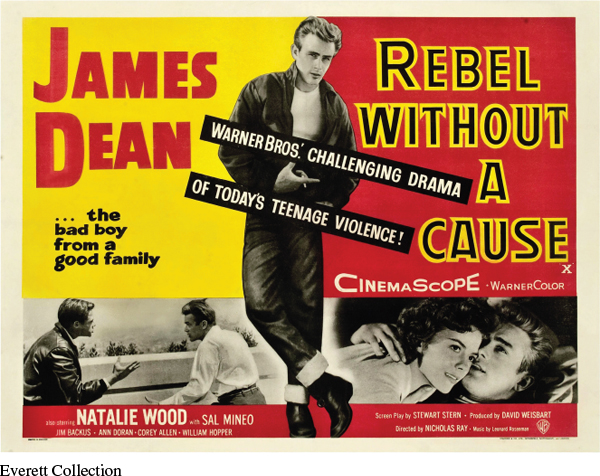Wild Ones on the Big Screen
If parents expected young people to behave like Ozzie and Harriet Nelson’s sons, the popular culture industry provided teenagers with alternative role models. In Rebel without a Cause (1955), actor James Dean portrayed a seventeen-year-old filled with anguish about his life. A sensitive but misunderstood young man, he muses that he wants “just one day when I wasn’t all confused . . . [when] I wasn’t ashamed of everything . . . [when] I felt I belonged some place.” The Wild One (1954), which starred Marlon Brando, also popularized youthful angst. The leather-outfitted leader of a motorcycle gang, Brando rides into a small town, hoping to shake it up. When asked by a local resident, “What are you rebelling against?” he coolly replies, “Whaddya got?” Real gangs did exist on the streets of New York and other major cities. Composed of working-class youth from various ethnic and racial backgrounds, these gangs were highly organized, controlled their neighborhood turfs, and engaged in “rumbles” (fights) with intruders. A romanticized version of these battles appeared on Broadway with the production of West Side Story (1957), which pitted a white gang against a Puerto Rican gang in a musical rendering of Romeo and Juliet.

Hollywood rarely portrayed women as rebels, but instead as mothers, understanding girlfriends, and dutiful wives. If they sought a career, like many of the women played by actor Doris Day, they pursued it only as long as necessary to meet the right man. Yet the film industry did offer a more tantalizing woman, a sexual being who displayed her attributes to seduce and outwit men. Marilyn Monroe in The Seven Year Itch (1955) and Elizabeth Taylor in Cat on a Hot Tin Roof (1958) revealed that women also had a powerful libido, though in the end they became domesticated or paid a terrible price.
Exploring American HistoriesPrinted Page 834
Exploring American Histories Value EditionPrinted Page 614
Chapter Timeline